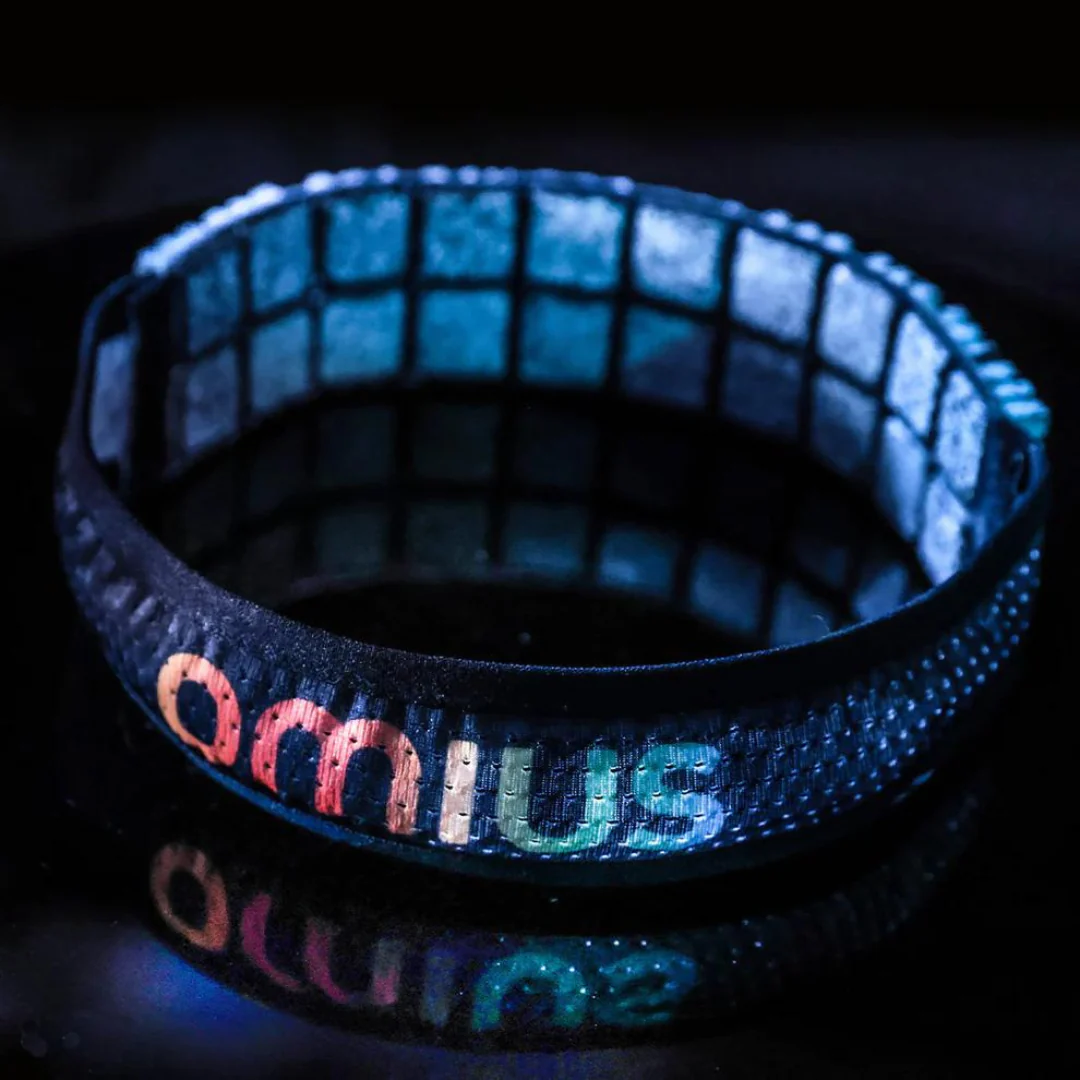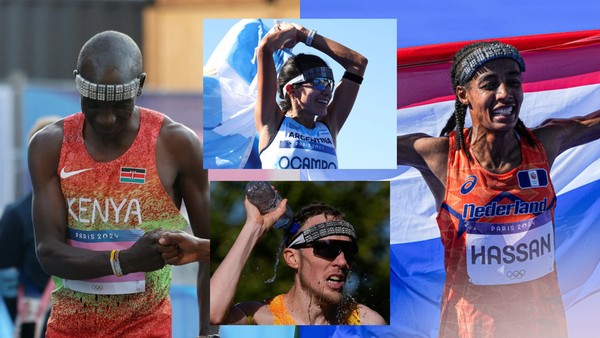During the Paris 2024 Olympics, the sight of marathon legends Eliud Kipchoge and Sifan Hassan wearing an unusual headband sparked widespread curiosity. The headband, developed by Omius, a company at the forefront of athletic innovation, boasts a hefty price tag of Ksh25,000 ($200) and offers a cutting-edge cooling system designed to enhance athletic performance in extreme conditions. While many questioned the impact of this gear, it became clear that the Omius headband might just be the latest technological advancement athletes use to gain a competitive edge.
What is the Omius Headband?
The Omius headband, introduced in 2019 and popularized post-pandemic in 2022, was initially designed for triathlon athletes who endure long periods of physical exertion under extreme conditions. At the Paris 2024 Olympics, its use by high-profile athletes like Kipchoge and Hassan brought it to the forefront of sports technology discussions.
This headband contains 20 cooling units, each composed of nine mini-towers made from porous, heat-conducting graphite. These towers amplify the surface area of the wearer’s forehead by five times, allowing for more efficient heat dissipation. The innovative design helps to draw heat away from the forehead through evaporation, creating a localized cooling effect that helps athletes feel cooler in hot, grueling conditions.
Though the headband doesn’t change an athlete’s core body temperature, it improves the comfort level during intense physical activities. This small but critical cooling effect can play a pivotal role in performance, especially in long-distance events like marathons.
How Does the Omius Headband Work?
The technology behind the Omius headband is based on a simple but effective principle: increasing the surface area of the skin in contact with the air promotes better evaporation, which in turn creates a cooling effect. The headband is kept slightly damp during use, allowing airflow to pass through the porous towers and evaporate the moisture, drawing heat away from the skin.
The headband’s 20 cooling units are replaceable, ensuring the headband maintains its efficiency over prolonged use. Athletes like Kipchoge and Hassan, competing under the scorching sun in marathon events, benefit from this advanced cooling system, as it helps keep their forehead cooler for longer periods, reducing discomfort and potentially allowing them to push harder during races.

According to Omius CEO Jake Leschly, the headband doesn’t alter the athlete’s core body temperature. Instead, it offers a localized cooling effect that helps athletes feel cooler, providing a psychological boost and improving their comfort during competitions. “It’s the local cooling effect that allows them to feel cooler and, potentially, perform faster,” Leschly said, emphasizing that while the headband may not dramatically change performance, it offers marginal gains that can be significant in high-stakes races.
Performance Benefits: Marginal Gains in Elite Sports
The Omius headband joins a growing list of performance-enhancing technologies in sports, much like the controversial “super shoes” worn by elite runners. While the headband’s exact impact on athletic performance is difficult to quantify, the cooling sensation it provides can give athletes an edge, particularly in endurance events where maintaining body temperature and energy levels is crucial.
Sifan Hassan’s victory in the women’s marathon and Eliud Kipchoge’s participation, despite his struggles, spotlighted the headband’s role in providing comfort in demanding conditions. Hassan’s success, along with Kenya’s Hellen Obiri finishing third, illustrates how important even the slightest performance boost can be at the highest levels of competition.
However, it’s important to recognize that while the headband may offer a cooling advantage, it does not substitute for the athlete’s skill, strength, endurance, and strategy. In Kipchoge’s case, despite wearing the Omius headband, he experienced an uncharacteristic struggle and ultimately dropped out of the marathon after 31 kilometers. This serves as a reminder that no technological aid can replace the physical and mental preparation required to perform at the highest level.
ALSO READ:
- CyBrian Kotut Reflects on Overcoming Doubts to Secure Second Place at Berlin Marathon with a Personal Best
- Faith Kipyegon Pockets $60,000 at Athlos NYC
- Faith Kipyegon and Mary Moraa Shine at Athlos NYC, Bagging Millions in Historic Female-Only Event
The Rise of the Omius Headband in Endurance Sports
The Omius headband has quickly gained popularity since sales resumed in 2022, following the COVID-19 pandemic. Its breakthrough moment came at the 2023 Women’s Ironman World Championship, where 43 of the 53 professional athletes wore the headband. The overwhelming adoption of the headband by endurance athletes shows its potential value in helping athletes withstand harsh conditions.
At the Paris Olympics, the headband was not a sponsored accessory for athletes like Kipchoge and Hassan, yet it still caught the attention of the global audience. The surge in sales post-Olympics demonstrates its growing influence, with nearly half as many headbands sold after the event as were sold throughout 2023.
While the headband’s popularity continues to soar, it’s not the only factor that determines athletic success. As demonstrated in Paris, athletes rely on a combination of skill, preparation, and strategy to win, with technological aids like the Omius headband offering marginal, yet valuable, assistance.

Future of the Omius Headband and Athletic Performance
As sports technology continues to evolve, we can expect to see more innovations like the Omius headband entering the competitive arena. The rise of marginal gains technology in endurance sports demonstrates the increasing importance of small advantages, especially in events where mere seconds can separate the winners from the rest.
The Omius headband’s adoption by elite athletes like Eliud Kipchoge and Sifan Hassan shows that even the most accomplished competitors seek every possible advantage. With sports becoming more data-driven and performance-focused, it’s likely that tools like the Omius headband will play an even larger role in the future of athletic training and competition.
Despite the high price point, the Ksh25,000 headband continues to gain traction, as athletes and teams look for ways to optimize performance, particularly in extreme weather conditions. As this technology advances, we may see even more refined versions of the headband that could offer even greater benefits.
A Small, Yet Significant Advantage
The Ksh25,000 Omius headband, worn by Eliud Kipchoge and Sifan Hassan at the Paris 2024 Olympics, offers a glimpse into the future of sports technology. By providing localized cooling in extreme conditions, the headband helps athletes feel more comfortable, potentially improving performance in high-pressure situations. While it won’t replace the rigorous training and dedication required for elite athletes, the headband represents one of the many tools available to gain marginal advantages that could make a difference in the world of competitive sports.
As more athletes adopt the Omius headband and other performance-enhancing technologies, we can expect to see further innovations that help push the limits of human endurance and athletic achievement. Whether it’s a small cooling effect or a pair of advanced running shoes, every edge counts when competing at the highest level.



